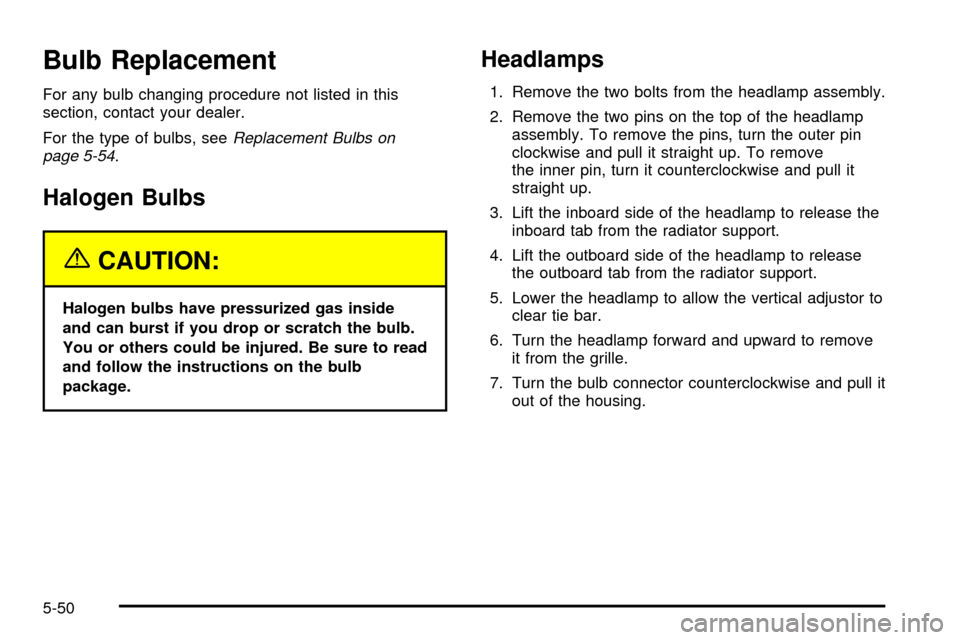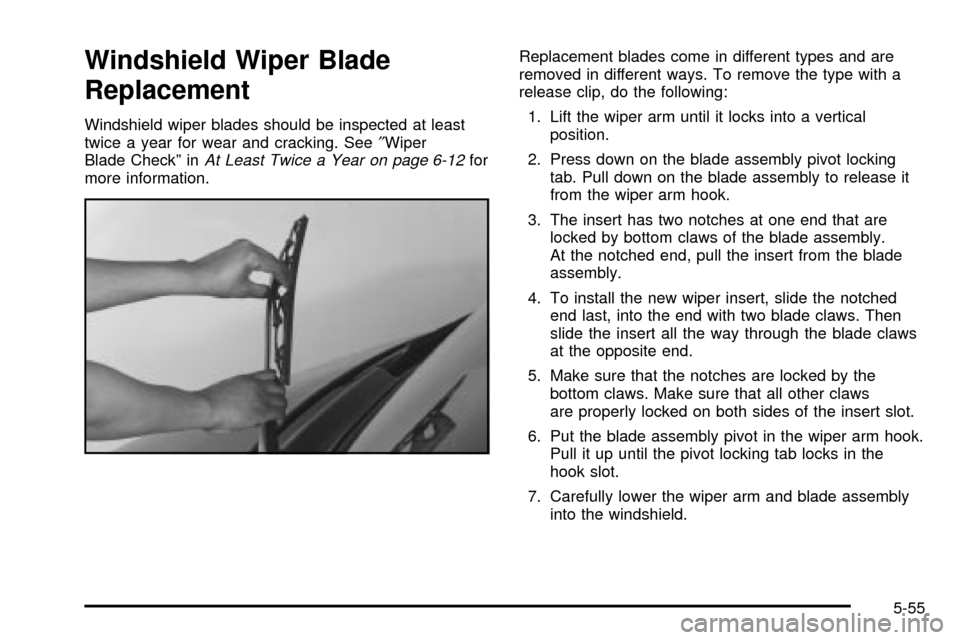Page 301 of 386
How to Add Coolant to the Radiator
1. You can remove the radiator pressure cap when
the cooling system, including the radiator pressure
cap and upper radiator hose, is no longer hot.
Turn the pressure cap slowly counterclockwise until
it ®rst stops. (Don't press down while turning the
pressure cap.)
If you hear a hiss, wait for that to stop. A hiss
means there is still some pressure left.2. Then keep turning the pressure cap, but now push
down as you turn it. Remove the pressure cap.
5-31
Page 320 of 386

Bulb Replacement
For any bulb changing procedure not listed in this
section, contact your dealer.
For the type of bulbs, see
Replacement Bulbs on
page 5-54.
Halogen Bulbs
{CAUTION:
Halogen bulbs have pressurized gas inside
and can burst if you drop or scratch the bulb.
You or others could be injured. Be sure to read
and follow the instructions on the bulb
package.
Headlamps
1. Remove the two bolts from the headlamp assembly.
2. Remove the two pins on the top of the headlamp
assembly. To remove the pins, turn the outer pin
clockwise and pull it straight up. To remove
the inner pin, turn it counterclockwise and pull it
straight up.
3. Lift the inboard side of the headlamp to release the
inboard tab from the radiator support.
4. Lift the outboard side of the headlamp to release
the outboard tab from the radiator support.
5. Lower the headlamp to allow the vertical adjustor to
clear tie bar.
6. Turn the headlamp forward and upward to remove
it from the grille.
7. Turn the bulb connector counterclockwise and pull it
out of the housing.
5-50
Page 321 of 386
8. Without removing the headlamp assembly itself,
remove the bulb socket from the back of the
headlamp on the driver's side.
9. Turn the bulb counterclockwise one quarter turn to
remove it from the socket.
10. On the passenger's side, turn the bulb clockwise
one turn. Do not touch the glass part of the bulb.11. Install the new bulb into the socket and return it to
the headlamp assembly.
12. Put the headlamp assembly back into the vehicle
and reinstall the two pins.
5-51
Page 322 of 386
Front Turn Signal, Sidemarker and
Parking Lamps
1. Use a small tool to unlatch the outboard clip on
this lamp.
2. Pull the lamp forward to completely unlatch the clip.
Move the lamp outboard to loosen the tabs.
3. Remove the lamp from the grille.
4. Squeeze the tab on the side of the bulb assembly
while turning it counterclockwise.
5. Remove the bulb assembly from the back of the
lens and replace the bulb.
6. Turn the socket clockwise to reinstall it in the lens
assembly.
Taillamps
1. Remove the two inboard nuts on the side assembly.
2. Pull side assembly rearward to clear studs.
3. Turn the side assembly on the outboard side,
releasing the upper clip.
4. Slide assembly slightly upward to release lower clip.
5. Reinstall the clips to the side assembly.
6. Remove the three nuts on the taillamp.
7. Remove the taillamp from the vehicle.
5-52
Page 323 of 386
8. To remove, squeeze the tab on the side of the
sockets while turning them counterclockwise.9. Turn the bulb counterclockwise to remove it. Install
the new bulb.
10. Reverse the above steps to reinstall the lamp.
5-53
Page 325 of 386

Windshield Wiper Blade
Replacement
Windshield wiper blades should be inspected at least
twice a year for wear and cracking. See²Wiper
Blade Checkº in
At Least Twice a Year on page 6-12for
more information.Replacement blades come in different types and are
removed in different ways. To remove the type with a
release clip, do the following:
1. Lift the wiper arm until it locks into a vertical
position.
2. Press down on the blade assembly pivot locking
tab. Pull down on the blade assembly to release it
from the wiper arm hook.
3. The insert has two notches at one end that are
locked by bottom claws of the blade assembly.
At the notched end, pull the insert from the blade
assembly.
4. To install the new wiper insert, slide the notched
end last, into the end with two blade claws. Then
slide the insert all the way through the blade claws
at the opposite end.
5. Make sure that the notches are locked by the
bottom claws. Make sure that all other claws
are properly locked on both sides of the insert slot.
6. Put the blade assembly pivot in the wiper arm hook.
Pull it up until the pivot locking tab locks in the
hook slot.
7. Carefully lower the wiper arm and blade assembly
into the windshield.
5-55
Page 335 of 386
Changing a Flat Tire
If a tire goes ¯at, avoid further tire and wheel damage
by driving slowly to a level place. Turn on your
hazard warning ¯ashers.
{CAUTION:
Changing a tire can cause an injury. The
vehicle can slip off the jack and roll over you
or other people. You and they could be badly
injured. Find a level place to change your tire.
To help prevent the vehicle from moving:
1. Set the parking brake ®rmly.
2. Put the shift lever in PARK (P).
3. Turn off the engine.
To be even more certain the vehicle won't
move, you can put blocks at the front and rear
of the tire farthest away from the one being
changed. That would be the tire on the other
side of the vehicle, at the opposite end.The following steps will tell you how to use the jack and
change a tire.
5-65
Page 338 of 386
Turn the ratchet counterclockwise to lower the spare tire
to the ground. If the spare tire does not lower to the
ground, the secondary latch is engaged causing the tire
not to lower. See ªSecondary Latch Systemº later in
this section.When the tire has been lowered, pull the tire toward you
so you can reach the tire retainer and pull it up
through the wheel opening.
If you have a vehicle which was completed from a cab
and chassis, refer to the information from the body
supplier/installer.
The spare tire is a full-size tire, like the other tires on
your vehicle.
Notice:To help avoid vehicle damage, do not drive
the vehicle before the cable is restored.
5-68